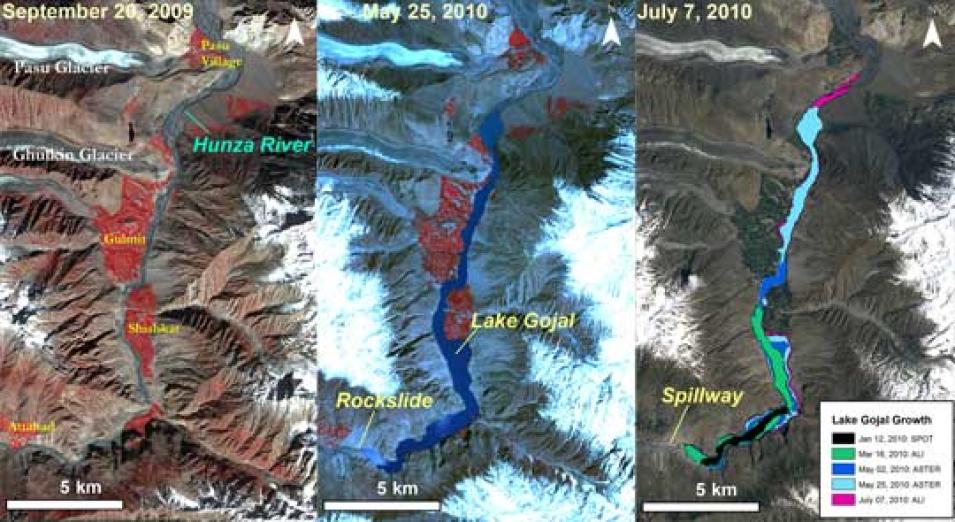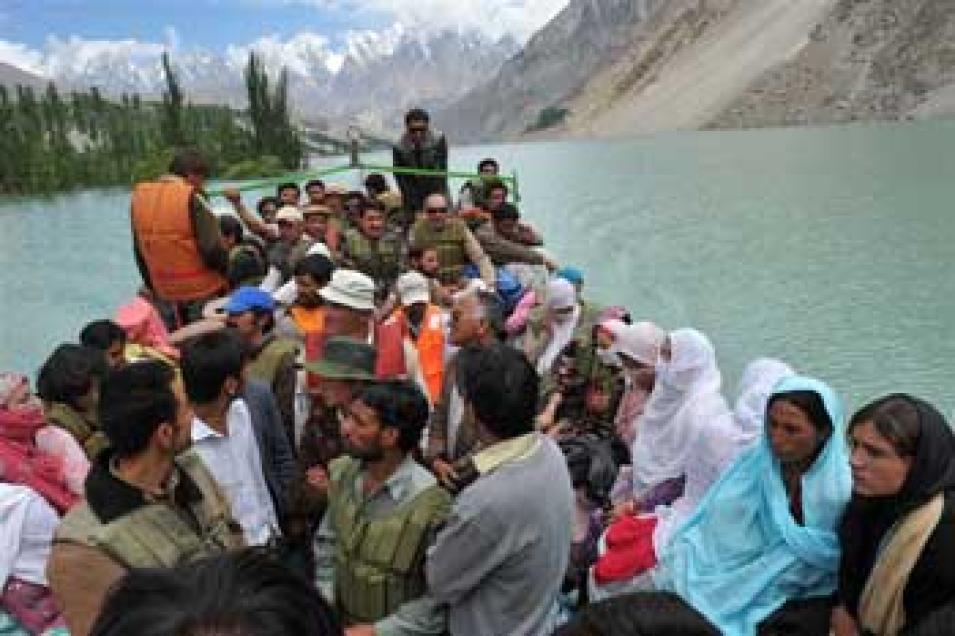A nervous sense of humor greets travelers at the highest and most scenic road in the world. Hand-painted signs saying, “Relax, slide area ends” dot sections of the Karakoram Highway along the Hunza River in northern Pakistan. Landslides are commonplace here. But on January 4, 2010, a massive rockslide buried part of a village and blocked the river’s flow. Boulders, rocks, and debris tumbled down the mountainside that day, killing twenty people and damming the river until it swelled and swallowed more communities. In months, the plugged-up river would submerge eleven miles of the Karakoram Highway, turning a thriving region buzzing with trade from the Chinese border into scattered clumps of unconnected villages.
Waiting for Gojal
A man stands in the middle of the Karakoram Highway while rocks tumble down into the Hunza River in Pakistan’s Gojal region. The rockslide dammed the river and created Lake Gojal, which submerged eleven miles of the Karakoram Highway and isolated several villages. (Courtesy I. Ali [Shimshal]/Pamir Times)
When hydrologist Jeffrey Kargel of the University of Arizona saw news footage of the rockslide, he had a hunch the flooded river could swell into a lake. He asked geologist Gregory Leonard to check recent satellite images of the area. “Sure enough, there was a lake forming behind the rockslide dam,” said Leonard, Kargel’s colleague at the University of Arizona. “It’s always startling to see the first images of these kinds of things.” Something else worried Kargel. Three huge glaciers, including the thirty-five-mile long Batura Glacier, are perched on the mountains above the flooded villages. In spring, those glaciers would start gushing melt water down into the new lake. Kargel said, “If the rockslide dam overflowed and burst, more people downstream would be in harm’s way.” Kargel studies glaciers and the hazards for communities living near them. He had the tools to figure out when the new Lake Gojal would overflow. But he and Leonard had to do it fast, if the information was to be of any help.
Bathtub model
In many ways, the birth of Lake Gojal was not a surprise. The Hunza River, from which it spawned, sits deep in a mountain valley with extremely steep slopes. “Masses of loose glacial sediment mantle some of these slopes,” Kargel said. The loose gravel, steep slopes, and the water that starts trickling down every spring from the Batura, Pasu, and Ghulkin glaciers have made the region notoriously vulnerable to rockslides and floods. While geologists have found evidence of rockslides that date back to the 1800s, the January 2010 rockslide that thundered into Hunza and snuffed out Attabad village was larger than usual, and finally succeeded in completely cutting off the river. It also cut off the rest of the world. Locals struggled to escape the area, and rescue workers toiled to haul aid and supplies to the isolated villages. With efforts focused on emergency response and disaster preparedness, Kargel and Leonard searched for reports on the new lake in the media and from colleagues.
These satellite images show how the January 2010 rockslide transformed the Hunza River into Lake Gojal. A year before the rockslide (left), the Hunza River, shown in gray, was a slender thread of water that wound its way through the Gojal Valley. Four months after the rockslide middle), a lake lies where the river once was (blue areas). Six months after the landslide (right), the lake kept growing even after a spillway was constructed to lower its water level. Much of its growth was near the dam a few months after the rockslide (black, green, and dark blue areas). Four days before the dam overflowed, much of the expansion happened in the northern section of the lake (light blue). (Courtesy J. Kargel/Copyright American Geophysical Union)
In Arizona, the two researchers decided to make a virtual three-dimensional model of the blocked valley and the lake that was growing inside the valley to determine when water would overflow the dam. They had to figure out how much water was already in it, and how much more was expected to flow into it once the nearby glaciers started sending melt water in the spring. “It’s like creating a bathtub model of the shape of this valley and the dam itself,” Leonard said. To create the model, they relied on data extracted from the Advanced Spaceborne Thermal Emission and Reflection Radiometer (ASTER) Global Digital Elevation Model (GDEM). They also analyzed a sequence of satellite images taken by the ASTER and Advanced Land Imager (ALI) instruments. The satellite images revealed the lake’s growth and its submergence of the Karakoram Highway and several villages, and how the land around the area had changed before and after the rockslide.
A swelling lake
They now knew what the shape of the tub looked like; the next challenge was to gauge how much water was flowing into it. Kargel found a thirty-year record of the Hunza River’s rate of flow. “That data set was really crucial,” he said. With it, they could estimate how much water was flowing into the lake, and how the lake would evolve. To identify the sources of glacier melt water above the valley, they used images from the Global Land Ice Measurements from Space (GLIMS) project. But they still needed to confirm some of the river flow and satellite data with field observations. Geoscientist Jean Schneider was already at Lake Gojal, working as a consultant for Pakistan’s National Disaster Management Authority (NDMA). He described what kind of rocks and soil had tumbled from the mountainside, measured everything that he could, and sent photographs. “Internet access was difficult in the region, so it was hard to get data to and from Jeffrey in the field,” said Schneider, who had to send the data from his office at the University of Vienna.
The researchers calculated that the lake’s volume was three to four times larger than what was being reported by the local media. They predicted on April 14, 2010, that the lake would overflow sometime from May 29 to June 1, and that there was a possibility that the rockslide dam would burst. “I was a little alarmed at the difference in our figures and what was being reported,” Kargel said. “So I approached the U.S. State Department’s Pakistan office, retired Pakistan military authorities who were still connected to the Pakistan NDMA, and I approached Focus Humanitarian Assistance Pakistan (AKDN). These urgent warnings apparently did reach the authorities in the field and presumably were of some use in planning and preparations for a possible flood.”
From mid-winter to late spring, disaster management crews had been carving out a spillway to ease the lake’s swelling, and evacuating communities. The growing lake had displaced more than a thousand people and destroyed homes, farms, and fruit orchards in the villages of Shishkat and Gulmit. As it turned out, the overflow began on May 29, and the spilling water soon grew to a torrent.
Forever or not
To the researchers’ surprise, the dam held as the water spilled over. Kargel said, “Everybody concerned, with one exception, was expecting a catastrophe of one magnitude or another.” That exception was hydrologist Victor Baker, Kargel’s colleague at the University of Arizona. Baker was convinced that the dam would hold and that the new lake would remain a lake for many years. “He believed that the dam’s downstream length was long enough and massive enough to prevent a rapid outburst,” Kargel said. The energy from water spilling over would be dissipated as it traversed the almost mile-long dam and would keep villages downstream safe. The lake would drain slowly and carve out a natural spillway through gradual erosion.
“Indeed, Baker has so far been correct,” Kargel said. However, Kargel and Leonard are not convinced that the lake is completely harmless. The rockslide dam contains clay from previous glacier melts and landslide-dammed lakes in the valley. Kargel believes the clay could deform over winters and springs as water inside it repeatedly freezes and thaws. Water seeping from within the dam might erode the clay and cause a catastrophic dam burst. Leonard said rockslide dams also typically burst shortly after an overflow. “This really is a big question,” he said. “We all wonder if this one is going to last a long time.”
Waiting game
As scientists debate Lake Gojal’s life expectancy, people displaced by the lake are scrambling for ways to live with it. Parts of the Karakoram Highway remain impassable, but boats and ferries now crowd makeshift docks at the lake’s spillway and at the northernmost shore in Hussaini village. However, the two-hour lake crossing is uncomfortable and somewhat dangerous. Boats are crammed with passengers, animals, and goods beyond their capacity. Sometimes, it is just not possible to travel to the isolated villages. “People can cross the lake only during daytime and when the weather is good,” said rescue volunteer Rehmat Ali Tajik. Locals wait for word of when Karakoram Highway will be repaired. Local journalist Noor Muhammad said, “There is a hope that roads will be constructed sooner or later. People know that the Karakoram Highway is very important to Pakistan and China.”
Meanwhile, the lake needs watching. Locals fear that Lake Gojal still holds a dangerous amount of water and have used hand tools to widen the spillway themselves. “The spillway has just not been able to bring the water level down considerably,” Muhammad said. Unusually warm weather could bring more water from the glaciers down to the lake. Kargel and his colleagues continue to distrust the dam. “The lake remains dangerous, in my opinion,” Kargel said. “We will keep a satellite’s eye view on the situation.” It may turn out to be a long vigil. “This lake could go at any time, or it could just last for centuries,” he said.
Reference
Kargel, J. S. and G. Leonard. 2010. Satellite monitoring of Pakistan’s rockslide-dammed Lake Gojal. Eos, Transactions, American Geophysical Union 91 (43):394-395.
For more information
NASA Land Processes Distributed Active Archive Center (LP DAAC)
NASA National Snow and Ice Data Center DAAC (NSIDC DAAC)
Advanced Spaceborne Thermal Emission and Reflection Radiometer (ASTER)
Earth Observing-1 (EO-1) Advanced Land Imager
Global Land Ice Measurements from Space (GLIMS)
| About the remote sensing data used | |||
| Satellites | Terra | Earth Observing 1 | |
|---|---|---|---|
| Sensors | Japan Ministry of Economy, Trade, and Industry (METI)/NASA's ASTER | Advanced Land Imager | |
| Data sets | EO-1 ALI Level 1 Gst | GLIMS Glacier Database | |
| Posting interval | 1 arc-second | N/A | |
| Resolution | 15 meter | 30 meter VNIR-SWIR bands, plus 10 meter panchromatic band | |
| Tile size | 1 degree x 1 degree | N/A | |
| Parameters | Elevation Radiance | Radiance | Glacier outlines |
| DAACs | LP DAAC | NASA LP DAAC | NSIDC DAAC |
The photograph in the title graphic shows the Khan family, who lost their home after the Hunza River was dammed by a rockslide and formed Lake Gojal. (Courtesy M. Pearson/ShelterBox)


